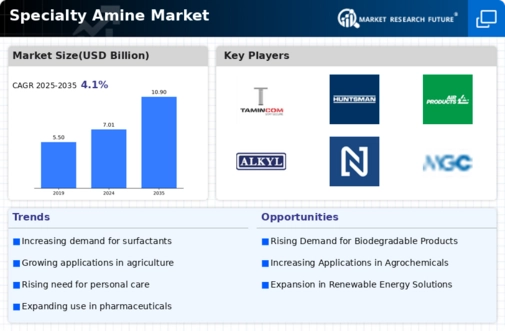Emerging Markets and Economic Growth
Emerging markets are playing a pivotal role in the expansion of the Global Specialty Amine Market Industry. Countries in Asia-Pacific and Latin America are witnessing rapid industrialization and urbanization, leading to increased demand for specialty amines in various applications. Economic growth in these regions is driving investments in sectors such as construction, automotive, and consumer goods, all of which utilize specialty amines. As these markets develop, the demand for specialty amines is expected to rise, contributing to the overall market growth trajectory. This trend is likely to support the market's projected CAGR of 4.12% from 2025 to 2035.
Growing Demand in End-Use Industries
The Global Specialty Amine Market Industry experiences a robust demand driven by various end-use sectors such as agriculture, pharmaceuticals, and personal care. Specialty amines are integral in producing agrochemicals, where they serve as intermediates for herbicides and pesticides. The pharmaceutical sector utilizes these compounds for drug formulation and synthesis, enhancing therapeutic efficacy. As these industries expand, the demand for specialty amines is expected to rise significantly. In 2024, the market is projected to reach 7.01 USD Billion, reflecting the increasing reliance on specialty amines across diverse applications.
Market Trends and Growth Projections
The Global Specialty Amine Market Industry is characterized by evolving market trends and growth projections. The market is expected to reach 7.01 USD Billion in 2024, with a steady increase anticipated over the next decade. By 2035, the market could expand to 10.9 USD Billion, reflecting a growing recognition of the versatility and utility of specialty amines across various sectors. The projected CAGR of 4.12% from 2025 to 2035 indicates a stable growth trajectory, driven by factors such as technological advancements, regulatory support, and increasing demand in end-use industries.
Rising Demand for Personal Care Products
The Global Specialty Amine Market Industry is significantly influenced by the increasing demand for personal care products. Specialty amines are utilized in formulations for hair care, skin care, and cosmetics, providing essential properties such as emulsification and surfactant capabilities. The growing consumer awareness regarding personal grooming and hygiene is propelling the market forward. As the beauty and personal care sector expands, manufacturers are likely to seek innovative specialty amines to enhance product performance. This trend contributes to the overall market growth, aligning with the anticipated increase in market value to 10.9 USD Billion by 2035.
Technological Advancements in Production
Technological innovations in the production of specialty amines are reshaping the Global Specialty Amine Market Industry. Enhanced manufacturing processes, such as continuous flow chemistry and green chemistry techniques, are being adopted to improve efficiency and reduce environmental impact. These advancements not only lower production costs but also enhance product quality and consistency. As manufacturers invest in state-of-the-art technologies, the market is likely to witness a surge in output capacity. This trend aligns with the projected growth of the market, which is expected to reach 10.9 USD Billion by 2035, indicating a strong future trajectory.
Regulatory Support for Sustainable Practices
The Global Specialty Amine Market Industry benefits from increasing regulatory support aimed at promoting sustainable practices. Governments worldwide are implementing stringent regulations to minimize environmental impact, encouraging the use of eco-friendly specialty amines. This regulatory landscape fosters innovation, as companies are motivated to develop greener alternatives that comply with environmental standards. The emphasis on sustainability is likely to drive market growth, as consumers and industries alike prioritize environmentally responsible products. As a result, the market is positioned for steady growth, with a projected CAGR of 4.12% from 2025 to 2035.














